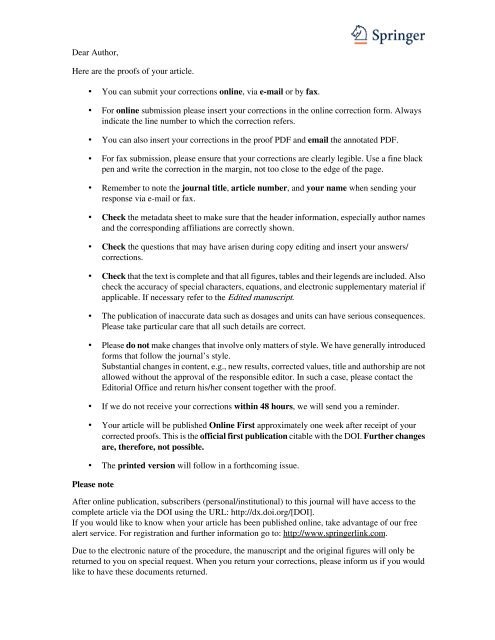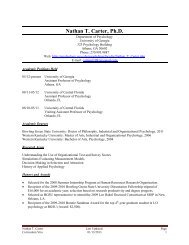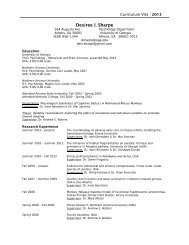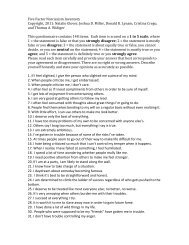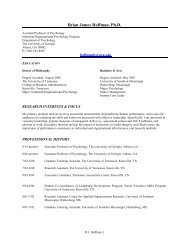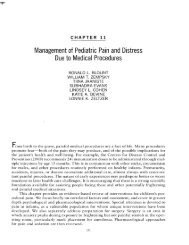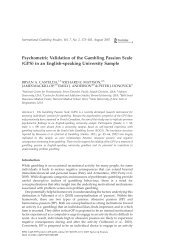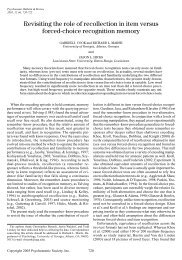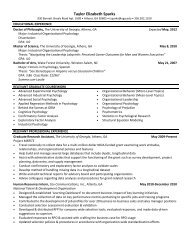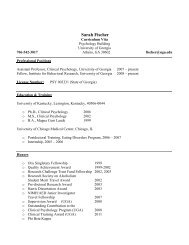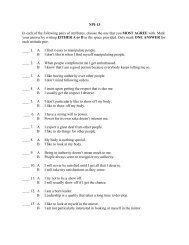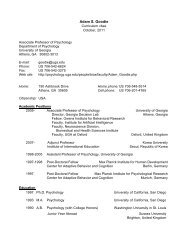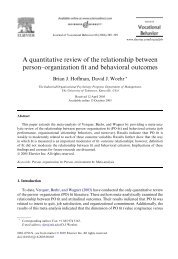Dear Author, Here are the proofs of your article. ⢠You can submit ...
Dear Author, Here are the proofs of your article. ⢠You can submit ...
Dear Author, Here are the proofs of your article. ⢠You can submit ...
Create successful ePaper yourself
Turn your PDF publications into a flip-book with our unique Google optimized e-Paper software.
<strong>Dear</strong> <strong>Author</strong>,<br />
<strong>Here</strong> <strong>are</strong> <strong>the</strong> <strong>pro<strong>of</strong>s</strong> <strong>of</strong> <strong>your</strong> <strong>article</strong>.<br />
• <strong>You</strong> <strong>can</strong> <strong>submit</strong> <strong>your</strong> corrections online, via e-mail or by fax.<br />
• For online submission please insert <strong>your</strong> corrections in <strong>the</strong> online correction form. Always<br />
indicate <strong>the</strong> line number to which <strong>the</strong> correction refers.<br />
• <strong>You</strong> <strong>can</strong> also insert <strong>your</strong> corrections in <strong>the</strong> pro<strong>of</strong> PDF and email <strong>the</strong> annotated PDF.<br />
• For fax submission, please ensure that <strong>your</strong> corrections <strong>are</strong> clearly legible. Use a fine black<br />
pen and write <strong>the</strong> correction in <strong>the</strong> margin, not too close to <strong>the</strong> edge <strong>of</strong> <strong>the</strong> page.<br />
• Remember to note <strong>the</strong> journal title, <strong>article</strong> number, and <strong>your</strong> name when sending <strong>your</strong><br />
response via e-mail or fax.<br />
• Check <strong>the</strong> metadata sheet to make sure that <strong>the</strong> header information, especially author names<br />
and <strong>the</strong> corresponding affiliations <strong>are</strong> correctly shown.<br />
• Check <strong>the</strong> questions that may have arisen during copy editing and insert <strong>your</strong> answers/<br />
corrections.<br />
• Check that <strong>the</strong> text is complete and that all figures, tables and <strong>the</strong>ir legends <strong>are</strong> included. Also<br />
check <strong>the</strong> accuracy <strong>of</strong> special characters, equations, and electronic supplementary material if<br />
applicable. If necessary refer to <strong>the</strong> Edited manuscript.<br />
• The publication <strong>of</strong> inaccurate data such as dosages and units <strong>can</strong> have serious consequences.<br />
Please take particular c<strong>are</strong> that all such details <strong>are</strong> correct.<br />
• Please do not make changes that involve only matters <strong>of</strong> style. We have generally introduced<br />
forms that follow <strong>the</strong> journal’s style.<br />
Substantial changes in content, e.g., new results, corrected values, title and authorship <strong>are</strong> not<br />
allowed without <strong>the</strong> approval <strong>of</strong> <strong>the</strong> responsible editor. In such a case, please contact <strong>the</strong><br />
Editorial Office and return his/her consent toge<strong>the</strong>r with <strong>the</strong> pro<strong>of</strong>.<br />
• If we do not receive <strong>your</strong> corrections within 48 hours, we will send you a reminder.<br />
• <strong>You</strong>r <strong>article</strong> will be published Online First approximately one week after receipt <strong>of</strong> <strong>your</strong><br />
corrected <strong>pro<strong>of</strong>s</strong>. This is <strong>the</strong> <strong>of</strong>ficial first publication citable with <strong>the</strong> DOI. Fur<strong>the</strong>r changes<br />
<strong>are</strong>, <strong>the</strong>refore, not possible.<br />
• The printed version will follow in a forthcoming issue.<br />
Please note<br />
After online publication, subscribers (personal/institutional) to this journal will have access to <strong>the</strong><br />
complete <strong>article</strong> via <strong>the</strong> DOI using <strong>the</strong> URL: http://dx.doi.org/[DOI].<br />
If you would like to know when <strong>your</strong> <strong>article</strong> has been published online, take advantage <strong>of</strong> our free<br />
alert service. For registration and fur<strong>the</strong>r information go to: http://www.springerlink.com.<br />
Due to <strong>the</strong> electronic nature <strong>of</strong> <strong>the</strong> procedure, <strong>the</strong> manuscript and <strong>the</strong> original figures will only be<br />
returned to you on special request. When you return <strong>your</strong> corrections, please inform us if you would<br />
like to have <strong>the</strong>se documents returned.
Metadata <strong>of</strong> <strong>the</strong> <strong>article</strong> that will be visualized in OnlineFirst<br />
ArticleTitle<br />
Article Sub-Title<br />
Article CopyRight<br />
Journal Name<br />
Social Density <strong>of</strong> Gambling and Its Association with Gambling Problems: An Initial Investigation<br />
Springer Science+Business Media, LLC<br />
(This will be <strong>the</strong> copyright line in <strong>the</strong> final PDF)<br />
Journal <strong>of</strong> Gambling Studies<br />
Corresponding <strong>Author</strong> Family Name Fortune<br />
P<strong>article</strong><br />
Given Name Erica E.<br />
Suffix<br />
Division<br />
Organization<br />
Address<br />
Email<br />
Department <strong>of</strong> Psychology<br />
University <strong>of</strong> Georgia<br />
A<strong>the</strong>ns, GA, 30602-3013, USA<br />
eelitt@uga.edu<br />
<strong>Author</strong> Family Name MacKillop<br />
P<strong>article</strong><br />
Given Name<br />
Suffix<br />
Division<br />
Organization<br />
Address<br />
Division<br />
Organization<br />
Address<br />
Email<br />
James<br />
<strong>Author</strong> Family Name Miller<br />
P<strong>article</strong><br />
Department <strong>of</strong> Psychology<br />
University <strong>of</strong> Georgia<br />
A<strong>the</strong>ns, GA, 30602-3013, USA<br />
Center for Alcohol and Addiction Studies<br />
Brown University<br />
Given Name Joshua D.<br />
Suffix<br />
Division<br />
Organization<br />
Address<br />
Email<br />
<strong>Author</strong> Family Name Campbell<br />
P<strong>article</strong><br />
Given Name<br />
Suffix<br />
Division<br />
Organization<br />
Address<br />
Email<br />
Providence, RI, USA<br />
Department <strong>of</strong> Psychology<br />
University <strong>of</strong> Georgia<br />
A<strong>the</strong>ns, GA, 30602-3013, USA<br />
W. Keith<br />
<strong>Author</strong> Family Name Clifton<br />
P<strong>article</strong><br />
Department <strong>of</strong> Psychology<br />
University <strong>of</strong> Georgia<br />
A<strong>the</strong>ns, GA, 30602-3013, USA
Given Name Allan D.<br />
Suffix<br />
Division<br />
Department <strong>of</strong> Psychology<br />
Organization<br />
Vassar College<br />
Address<br />
124 Raymond Ave., Box 713, Poughkeepsie, NY, 12604-0713, USA<br />
Email<br />
<strong>Author</strong> Family Name Goodie<br />
P<strong>article</strong><br />
Given Name Adam S.<br />
Suffix<br />
Division<br />
Department <strong>of</strong> Psychology<br />
Organization<br />
University <strong>of</strong> Georgia<br />
Address<br />
A<strong>the</strong>ns, GA, 30602-3013, USA<br />
Email<br />
Schedule<br />
Abstract<br />
Keywords (separated by '-')<br />
Footnote Information<br />
Received<br />
Revised<br />
Accepted<br />
The role <strong>of</strong> social factors in pathological gambling has received relatively little systematic research. The goal<br />
<strong>of</strong> <strong>the</strong> current study was to examine <strong>the</strong> relationship between a target individual’s gambling behavior and <strong>the</strong><br />
gambling behavior among that individual’s p<strong>are</strong>nts, siblings and five closest friends. The specific aims were,<br />
first, to apply a novel brief assessment to study <strong>the</strong> social density <strong>of</strong> factors relating to pathological gambling;<br />
second, to replicate previously observed findings involving <strong>the</strong> social aggregation <strong>of</strong> alcohol and tobacco use;<br />
and third, to examine social density findings among <strong>the</strong> three domains. Participants were 128 frequent<br />
gamblers from <strong>the</strong> A<strong>the</strong>ns, Georgia <strong>are</strong>a, 79.7 % male with a mean age <strong>of</strong> 34.2 (SD = 11.7). Participants were<br />
assessed using <strong>the</strong> Diagnostic Interview for Gambling Severity for gambling severity, <strong>the</strong> Alcohol Use<br />
Disorders Identification Test for alcohol abuse, <strong>the</strong> Fagerstrom Test <strong>of</strong> Nicotine Dependence for tobacco use,<br />
and <strong>the</strong> novel Brief Social Density <strong>of</strong> Gambling, Alcohol, and Tobacco Assessment. Signifi<strong>can</strong>t relationships<br />
were observed between participants’ and friends’ activity within all domains: gambling (ps = .001), alcohol<br />
use (p < .001) and tobacco use (p < .001). Relationships with friends’ activity across domains were less strong.<br />
Distinct patterns <strong>of</strong> associations with p<strong>are</strong>nts and siblings were not observed. Thus, social aggregation was<br />
observed across <strong>the</strong> three domains <strong>of</strong> potentially addictive behaviors, generally with specificity within<br />
domains and with friends, not biological relatives. Methodological considerations and potential applications<br />
<strong>of</strong> <strong>the</strong>se findings <strong>are</strong> discussed.<br />
Gambling - Pathological gambling - Social density - Tobacco - Alcohol
Journal: 10899<br />
Article: 9303<br />
<strong>Author</strong> Query Form<br />
Please ensure you fill out <strong>your</strong> response to <strong>the</strong> queries raised below<br />
and return this form along with <strong>your</strong> corrections<br />
<strong>Dear</strong> <strong>Author</strong><br />
During <strong>the</strong> process <strong>of</strong> typesetting <strong>your</strong> <strong>article</strong>, <strong>the</strong> following queries have arisen. Please<br />
check <strong>your</strong> typeset pro<strong>of</strong> c<strong>are</strong>fully against <strong>the</strong> queries listed below and mark <strong>the</strong><br />
necessary changes ei<strong>the</strong>r directly on <strong>the</strong> pro<strong>of</strong>/online grid or in <strong>the</strong> „<strong>Author</strong>‟s response‟<br />
<strong>are</strong>a provided below<br />
Query Details required <strong>Author</strong>’s response<br />
1. Please check and confirm <strong>the</strong> author<br />
names and initials <strong>are</strong> correct. Also,<br />
kindly confirm <strong>the</strong> details in <strong>the</strong><br />
metadata <strong>are</strong> correct.<br />
2. Please check and confirm <strong>the</strong> inserted<br />
city, state and country name is correct<br />
and amend if necessary.<br />
3. Please note that section heading<br />
"Introduction" is added as per journal<br />
style.<br />
4. Please check and confirm <strong>the</strong> section<br />
headings <strong>are</strong> correctly identified.<br />
5. Black (2006) has been changed to Black<br />
et al. (2006) so that this citation<br />
matches <strong>the</strong> list.<br />
6. Please provide <strong>the</strong> appropriate<br />
“Acknowledgments” text.
Journal : Small 10899 Dispatch : 4-4-2012 Pages : 14<br />
Article No. : 9303 h LE h TYPESET<br />
MS Code : JOGS637 h4 CP h4<br />
DISK<br />
J Gambl Stud<br />
DOI 10.1007/s10899-012-9303-3<br />
1 ORIGINAL PAPER<br />
<strong>Author</strong> Pro<strong>of</strong><br />
2 Social Density <strong>of</strong> Gambling and Its Association<br />
3 with Gambling Problems: An Initial Investigation<br />
4 Erica E. Fortune • James MacKillop • Joshua D. Miller •<br />
5 W. Keith Campbell • Allan D. Clifton • Adam S. Goodie<br />
6<br />
7 Ó Springer Science+Business Media, LLC 2012<br />
8 Abstract The role <strong>of</strong> social factors in pathological gambling has received relatively little<br />
9 systematic research. The goal <strong>of</strong> <strong>the</strong> current study was to examine <strong>the</strong> relationship between<br />
10 a target individual’s gambling behavior and <strong>the</strong> gambling behavior among that individual’s<br />
11 p<strong>are</strong>nts, siblings and five closest friends. The specific aims were, first, to apply a novel<br />
12 brief assessment to study <strong>the</strong> social density <strong>of</strong> factors relating to pathological gambling;<br />
13 second, to replicate previously observed findings involving <strong>the</strong> social aggregation <strong>of</strong><br />
14 alcohol and tobacco use; and third, to examine social density findings among <strong>the</strong> three<br />
15 domains. Participants were 128 frequent gamblers from <strong>the</strong> A<strong>the</strong>ns, Georgia <strong>are</strong>a, 79.7 %<br />
16 male with a mean age <strong>of</strong> 34.2 (SD=11.7). Participants were assessed using <strong>the</strong> Diag-<br />
17 nostic Interview for Gambling Severity for gambling severity, <strong>the</strong> Alcohol Use Disorders<br />
18 Identification Test for alcohol abuse, <strong>the</strong> Fagerstrom Test <strong>of</strong> Nicotine Dependence for<br />
19 tobacco use, and <strong>the</strong> novel Brief Social Density <strong>of</strong> Gambling, Alcohol, and Tobacco<br />
20 Assessment. Signifi<strong>can</strong>t relationships were observed between participants’ and friends’<br />
21 activity within all domains: gambling (ps=.001), alcohol use (p\.001) and tobacco use<br />
22 (p\.001). Relationships with friends’ activity across domains were less strong. Distinct<br />
23 patterns <strong>of</strong> associations with p<strong>are</strong>nts and siblings were not observed. Thus, social aggre-<br />
24 gation was observed across <strong>the</strong> three domains <strong>of</strong> potentially addictive behaviors, generally<br />
25 with specificity within domains and with friends, not biological relatives. Methodological<br />
26 considerations and potential applications <strong>of</strong> <strong>the</strong>se findings <strong>are</strong> discussed.<br />
27 Keywords Gambling Pathological gambling Social density Tobacco Alcohol<br />
A1<br />
A2<br />
A3<br />
A4<br />
A5<br />
E. E. Fortune (&) J. MacKillop J. D. Miller W. K. Campbell A. S. Goodie<br />
Department <strong>of</strong> Psychology, University <strong>of</strong> Georgia, A<strong>the</strong>ns, GA 30602-3013, USA<br />
e-mail: eelitt@uga.edu<br />
UNCORRECTED PROOF<br />
J. MacKillop<br />
Center for Alcohol and Addiction Studies, Brown University, Providence, RI, USA<br />
A6<br />
A7<br />
A8<br />
A. D. Clifton<br />
Department <strong>of</strong> Psychology, Vassar College, 124 Raymond Ave., Box 713, Poughkeepsie,<br />
NY 12604-0713, USA<br />
123
Journal : Small 10899 Dispatch : 4-4-2012 Pages : 14<br />
Article No. : 9303 h LE h TYPESET<br />
MS Code : JOGS637 h4 CP h4<br />
DISK<br />
J Gambl Stud<br />
28 Introduction<br />
<strong>Author</strong> Pro<strong>of</strong><br />
29 Social network analysis (SNA) is a promising methodology for <strong>the</strong> study <strong>of</strong> psychopa-<br />
30 thology in general (Cramer et al. 2010) and addictive behavior in particular (Christakis and<br />
31 Fowler 2008). For example, in large social networks, clusters <strong>of</strong> drinkers <strong>can</strong> be quanti-<br />
32 tatively discerned, and network-level changes in drinking over time signifi<strong>can</strong>tly affect<br />
33 individual-level drinking patterns (Rosenquist et al. 2010). Familial and social factors <strong>are</strong><br />
34 commonly <strong>the</strong>orized to influence <strong>the</strong> development and trajectory <strong>of</strong> addictive disorders,<br />
35 and pathological gambling (PG) is no exception. There is an inherent social component to<br />
36 various gambling modalities, including many casino games, poker, and sports pools, which<br />
37 proves to be a signifi<strong>can</strong>t motivation for gambling involvement among many gamblers<br />
38 (Lee et al. 2006; Neighbors et al. 2002). There is a small but consistent literature to suggest<br />
39 that social factors contribute to PG among juveniles (Gupta and Derevensky 1997), ado-<br />
40 lescents (Fried et al. 2010), college students (Neighbors et al. 2002) and older adults<br />
41 (McNeilly and Burke 2001).<br />
42 Although <strong>the</strong> most app<strong>are</strong>nt social motivation for gambling may be socializing with<br />
43 friends and <strong>the</strong> opportunity to meet new people, o<strong>the</strong>r social factors may also be operative.<br />
44 For example, social norms and perceptions <strong>can</strong> influence decisions to engage in certain<br />
45 risky activities (Welte et al. 2006). Greater social availability (<strong>the</strong> favorability <strong>of</strong> one’s<br />
46 social group’s views <strong>of</strong> an activity) is related to gambling behavior, with participants’<br />
47 gambling activity being signifi<strong>can</strong>tly correlated with more favorable perceptions <strong>of</strong> gam-<br />
48 bling from friends and family (Delfabbro and Thrupp 2003; Martin et al. 2010; Welte et al.<br />
49 2006). Understandably, those family members and friends who have more favorable views<br />
50 <strong>are</strong> also more likely to actively engage in gambling <strong>the</strong>mselves. In a sample <strong>of</strong> juvenile<br />
51 gamblers aged 9–14, Gupta and Derevensky (1997) found that 81 % gambled with<br />
52 immediate family (i.e., p<strong>are</strong>nts and siblings) and o<strong>the</strong>r relatives. While this familial<br />
53 influence remained relatively stable from <strong>the</strong> youngest to <strong>the</strong> oldest juveniles in <strong>the</strong> sample,<br />
54 gambling with friends increased dramatically from 33 % in 4th Grade, to 60 % in 6th<br />
55 Grade, and to 76 % in 8th grade. Based on <strong>the</strong>se findings, <strong>the</strong> authors suggest that p<strong>are</strong>nts’<br />
56 gambling habits may be more directly related to <strong>the</strong> acquisition <strong>of</strong> gambling behavior,<br />
57 whereas friends’ gambling habits may be more associated with <strong>the</strong> maintenance <strong>of</strong><br />
58 gambling.<br />
59 It has also been found that relatives <strong>of</strong> PGs <strong>are</strong> at increased risk to suffer from a<br />
60 gambling disorder <strong>the</strong>mselves. For example, relatives <strong>of</strong> PGs <strong>are</strong> nearly four times as likely<br />
61 to suffer from a gambling disorder than relatives <strong>of</strong> nonpathological gamblers (NPGs),<br />
62 with lifetime rates <strong>of</strong> PG for <strong>the</strong>se relatives being 8.3 and 2.1 %, respectively (Black et al.<br />
63 2006). Focusing specifically on <strong>the</strong> p<strong>are</strong>nt–child correlation, <strong>the</strong> paternal influence on<br />
64 <strong>of</strong>fspring has been shown to be greater than that <strong>of</strong> <strong>the</strong> maternal influence. In a sample <strong>of</strong><br />
65 189 families, Oei and Raylu (2004) found that mo<strong>the</strong>rs’ scores on <strong>the</strong> South Oaks Gam-<br />
66 bling Screen (SOGS; Lesieur and Blume 1987) had essentially no bearing on <strong>of</strong>fspring<br />
67 SOGS scores (r=0.02), although fa<strong>the</strong>rs’ SOGS scores had a highly signifi<strong>can</strong>t rela-<br />
68 tionship to <strong>of</strong>fspring SOGS scores (r=0.74). From a social learning perspective (Bandura<br />
69 1977), direct engagement in gambling activity with p<strong>are</strong>nts is not a necessary precursor for<br />
70 influential effects to occur on one’s own gambling behaviors. Through modeling, indi-<br />
71 viduals may be influenced by exposure to <strong>the</strong> behaviors <strong>of</strong> o<strong>the</strong>rs, such as how <strong>the</strong>ir friends<br />
72 and family allocate <strong>the</strong>ir time and money to gambling-related activities. Indeed, <strong>the</strong><br />
73 children <strong>of</strong> p<strong>are</strong>nts who effectively model good money management skills expressed less<br />
74 interest in future gambling than children whose p<strong>are</strong>nts did not emphasize <strong>the</strong> importance<br />
75 <strong>of</strong> managing money responsibly (Delfabbro and Thrupp 2003).<br />
UNCORRECTED PROOF<br />
123
J Gambl Stud<br />
Journal : Small 10899 Dispatch : 4-4-2012 Pages : 14<br />
Article No. : 9303 h LE h TYPESET<br />
MS Code : JOGS637 h4 CP h4<br />
DISK<br />
<strong>Author</strong> Pro<strong>of</strong><br />
76 Modeling has also been implicated in connection to substance use in adolescents, with<br />
77 both friends and p<strong>are</strong>nts playing an important role in <strong>the</strong> acquisition <strong>of</strong> alcohol con-<br />
78 sumption (Bank et al. 1985) and tobacco habits (Flay et al. 1994). The combined influence<br />
79 <strong>of</strong> friends and p<strong>are</strong>nts have been shown to account for more than 30 % <strong>of</strong> <strong>the</strong> variance in<br />
80 both tobacco use and alcohol consumption among adolescents (Kinard and Webster 2010),<br />
81 but friends ultimately play a more signifi<strong>can</strong>t and direct role in adolescents’ substance use<br />
82 than p<strong>are</strong>nts (Bank et al. 1985; Flay et al. 1994; Kinard and Webster 2010). In addition, it<br />
83 has also been suggested that siblings play a more critical role in substance use than p<strong>are</strong>nts,<br />
84 even when controlling for sh<strong>are</strong>d environmental experiences (Fagan and Najman 2005).<br />
85 Peer and familial influences on substance use <strong>are</strong> clearly present during adolescence and<br />
86 <strong>can</strong> still be seen in adulthood, with SNA showing increased drinking for individuals with<br />
87 heavy drinkers in <strong>the</strong>ir social network (Rosenquist et al. 2010) and alcohol-specific support<br />
88 from one’s social network impacting treatment success (Longabaugh et al. 2010). Using<br />
89 <strong>the</strong> Important People Inventory (IPI) in a clinical context, Longabaugh and colleagues<br />
90 found post-treatment percentage days abstinent was signifi<strong>can</strong>tly related to <strong>the</strong> frequency<br />
91 <strong>of</strong> alcohol use observed in patients’ social networks. Similarly, smoking cessation main-<br />
92 tenance has been shown to have a negative relationship with <strong>the</strong> existence <strong>of</strong> smokers in<br />
93 one’s social network (Mermelstein et al. 1986) and SNA for tobacco use indicates that it is<br />
94 more common for successful smoking cessation to simultaneously occur for multiple<br />
95 smokers within <strong>the</strong> same social network as opposed to an individual smoker (Christakis<br />
96 and Fowler 2008).<br />
97 Despite <strong>the</strong> clear relevance <strong>of</strong> social network influences, we <strong>are</strong> aw<strong>are</strong> <strong>of</strong> no studies to<br />
98 date that have applied SNA to PG. Therefore, <strong>the</strong> current study was an initial investigation<br />
99 <strong>of</strong> <strong>the</strong> relationship between an individual’s gambling behavior and <strong>the</strong> gambling behavior<br />
100 in <strong>the</strong> individual’s social network, to lay <strong>the</strong> groundwork for more methodologically<br />
101 rigorous SNA gambling studies in <strong>the</strong> future. More specifically, <strong>the</strong> primary aim <strong>of</strong> <strong>the</strong><br />
102 current study was to use a novel social density measure to characterize <strong>the</strong> relationship<br />
103 between <strong>the</strong> severity <strong>of</strong> participants’ PG and <strong>the</strong> frequency <strong>of</strong> gambling and monetary<br />
104 losses for individuals within <strong>the</strong>ir social network. Participants’ social networks were op-<br />
105 erationalized to include: (a) p<strong>are</strong>nts, (b) siblings, and (c) <strong>the</strong> five o<strong>the</strong>r closest people in<br />
106 <strong>the</strong>ir lives. We predicted that we would observe a signifi<strong>can</strong>t association between partic-<br />
107 ipants’ level <strong>of</strong> pathology and <strong>the</strong> levels <strong>of</strong> gambling observed in <strong>the</strong>ir proximal social<br />
108 networks. A secondary aim <strong>of</strong> <strong>the</strong> current study was to investigate <strong>the</strong> same relationships<br />
109 for alcohol and tobacco use. We expected aggregation within social networks on <strong>the</strong>se<br />
110 behaviors as well. As a third aim, we examined whe<strong>the</strong>r participants’ behaviors in one<br />
111 domain (e.g., gambling) would be related to network members’ behaviors in alternative<br />
112 domains (e.g., alcohol use).We did not make specific predictions for <strong>the</strong>se cross-modal<br />
113 relationships.<br />
114 Methods<br />
115 Participants<br />
UNCORRECTED PROOF<br />
116 Participants included 128 frequent gamblers (i.e., gambled at least weekly), who were<br />
117 recruited with newspaper advertisements and word <strong>of</strong> mouth in A<strong>the</strong>ns, GA, USA. Par-<br />
118 ticipants were 79.7 % male with a mean age <strong>of</strong> 34.2 (SD=11.7) who primarily self-<br />
119 identified as white (39.8 %) or black (57.0 %). The current results <strong>are</strong> part <strong>of</strong> a larger<br />
120 ongoing study that includes measures <strong>of</strong> personality, behavioral risk taking and o<strong>the</strong>r<br />
123
Journal : Small 10899 Dispatch : 4-4-2012 Pages : 14<br />
Article No. : 9303 h LE h TYPESET<br />
MS Code : JOGS637 h4 CP h4<br />
DISK<br />
J Gambl Stud<br />
<strong>Author</strong> Pro<strong>of</strong><br />
121 individual difference variables. Individuals were excluded from participation if <strong>the</strong>y: (1)<br />
122 did not gamble at least once a week, (2) currently lived with someone who already<br />
123 completed <strong>the</strong> study, (3) could not use a computer, (4) reported symptoms <strong>of</strong> psychosis, or<br />
124 (5) were older than 65.<br />
125 Procedure<br />
126 Eligible individuals completed a single in-person session, in which <strong>the</strong>y first completed a<br />
127 demographic questionnaire on a computer in an individual lab room, next took part in a<br />
128 one-on-one diagnostic interview with a trained masters-level interviewer to determine<br />
129 gambling pathology, and finally completed <strong>the</strong> assessment <strong>of</strong> gambling, alcohol use, and<br />
130 tobacco use within <strong>the</strong>ir social networks. All procedures were approved by <strong>the</strong> University<br />
131 <strong>of</strong> Georgia Institutional Review Board and were consistent with <strong>the</strong> Helsinki Declaration.<br />
132 Participants were paid $30 US for <strong>the</strong>ir participation in <strong>the</strong> overall study.<br />
133 Measures<br />
134 Diagnostic Interview for Gambling Severity (DIGS; Winters et al. 1996)<br />
135 This semi-structured clinical interview is based on <strong>the</strong> 10 DSM-IV diagnostic criteria for<br />
136 PG. The 20 items <strong>are</strong> paraphrased directly from <strong>the</strong> DSM-IV criteria, with 2 items for each<br />
137 criterion, grouped into pairs to reflect <strong>the</strong> dichotomous nature <strong>of</strong> <strong>the</strong> 10 criteria. Following<br />
138 a face-to-face interview, a trained interviewer determined whe<strong>the</strong>r each item was false,<br />
139 somewhat true, orvery true, based upon <strong>the</strong> participants’ responses. Within each <strong>of</strong> <strong>the</strong><br />
140 item pairs, two classifications <strong>of</strong> somewhat true or at least one answer <strong>of</strong> very true resulted<br />
141 in <strong>the</strong> participant receiving a point. The total score was assessed on a scale <strong>of</strong> 1–10, with a<br />
142 score <strong>of</strong> 5 or higher indicating PG status. Administration <strong>of</strong> <strong>the</strong> DIGS probes specific<br />
143 gambling modalities including playing cards, betting on sporting events, playing <strong>the</strong> lottery<br />
144 and playing slot machines, but it does not mandate that gambling-related problems be<br />
145 restricted to <strong>the</strong>se forms <strong>of</strong> gambling. Participants reported engaging in a wide range <strong>of</strong><br />
146 gambling activities, including lottery play, cards, dice, sports betting and internet gaming.<br />
147 Alcohol Use Disorders Identification Test (AUDIT; Saunders et al. 1993)<br />
148 This 10-item assessment addresses <strong>the</strong> frequency, amount, and possible consequences <strong>of</strong><br />
149 alcohol consumption. Total scores <strong>can</strong> range from 0 to 40 with a score <strong>of</strong> 8 or higher<br />
150 indicating hazardous drinking.<br />
151 Fagerstrom Test for Nicotine Dependence (FTND; Hea<strong>the</strong>rton et al. 1991)<br />
UNCORRECTED PROOF<br />
152 The FTND is used to assess nicotine dependence by assigning a nicotine rating from 1 to<br />
153 10, as based on particular smoking behaviors that individuals endorse. The FTND has been<br />
154 shown to have good convergent validity with various biochemical measures <strong>of</strong> smoking,<br />
155 including cotinine and nicotine in saliva (Hea<strong>the</strong>rton et al. 1991).<br />
123
J Gambl Stud<br />
Journal : Small 10899 Dispatch : 4-4-2012 Pages : 14<br />
Article No. : 9303 h LE h TYPESET<br />
MS Code : JOGS637 h4 CP h4<br />
DISK<br />
156 Brief Addictive Behavior Social Density Assessment: Gambling, Alcohol, and Tobacco<br />
157 (BASDA; See ‘‘Appendix’’)<br />
<strong>Author</strong> Pro<strong>of</strong><br />
158 The BASDA adapted elements <strong>of</strong> validated screening measures <strong>of</strong> gambling, alcohol use,<br />
159 and tobacco use to investigate <strong>the</strong>se behaviors among each member <strong>of</strong> a participant’s social<br />
160 network, including <strong>the</strong> five closest non-biological social associates (e.g., friends, romantic<br />
161 partners and o<strong>the</strong>r close acquaintances, whom we refer to collectively as ‘‘friends’’), living<br />
162 p<strong>are</strong>nts, and living siblings. Participants estimated <strong>the</strong> gambling and substance use <strong>of</strong> each<br />
163 individual and rated <strong>the</strong>ir confidence in <strong>the</strong>ir estimate. In completing <strong>the</strong> BASDA for <strong>the</strong>ir<br />
164 five closest friends, participants were given <strong>the</strong> following description:<br />
165 Please provide estimates <strong>of</strong> <strong>the</strong>se behaviors for <strong>your</strong> CLOSEST non-biologically<br />
166 related individuals, including spouses and signifi<strong>can</strong>t o<strong>the</strong>rs. Please note, <strong>the</strong> term<br />
167 ‘‘non-biologically related individual’’ is meant specifically to exclude p<strong>are</strong>nts and<br />
168 siblings. It is however acceptable for <strong>your</strong> closest people to include o<strong>the</strong>r relatives<br />
169 (e.g., cousins, aunts, uncles, etc.), but please note that in <strong>the</strong> appropriate location<br />
170<br />
171<br />
below.<br />
172 When completing <strong>the</strong> sibling portion <strong>of</strong> <strong>the</strong> BASDA, participants were instructed to<br />
173 start with <strong>the</strong> sibling closest in age to <strong>the</strong>mselves and continue to siblings <strong>of</strong><br />
174 increasingly distant ages until completing <strong>the</strong> questionnaire for all living siblings. With<br />
175 regard to <strong>the</strong> gambling behaviors, participants estimated each individual’s weekly fre-<br />
176 quency <strong>of</strong> gambling on an 8-point scale from ‘‘no days’’ to ‘‘every day’’ as well as<br />
177 weekly expenditure on gambling-related activities in an open response format. These<br />
178 items were based on <strong>the</strong> South Oaks Gambling Screen (SOGS; Lesieur and Blume<br />
179 1987). The alcohol portion <strong>of</strong> <strong>the</strong> BASDA used <strong>the</strong> AUDIT-Quantity-Frequency index,<br />
180 <strong>the</strong> first three items pertaining to heaviness <strong>of</strong> alcohol use, which has been validated as<br />
181 a measure <strong>of</strong> problematic alcohol consumption (Bush et al. 1998). Tobacco use for<br />
182 individuals was assessed as cig<strong>are</strong>ttes/day, which is a validated indicator <strong>of</strong> cig<strong>are</strong>tte<br />
183 consumption and an item on <strong>the</strong> FTND. To be maximally representative, a composite <strong>of</strong><br />
184 <strong>the</strong> five closest friends was used. Internal consistency was calculated for distinct<br />
185 BASDA categories by treating each <strong>of</strong> <strong>the</strong> five closest friends’ responses as items. The<br />
186 internal consistency levels were good for gambling frequency (a=.79), gambling<br />
187 expenditure (a=.78), and alcohol use (a=.70), but suboptimal for tobacco use<br />
188 (a=.41). This last finding may reflect <strong>the</strong> fact that <strong>the</strong> social network questionnaire<br />
189 asked one tobacco-use question about each network member, whereas it asked multiple<br />
190 questions about gambling and alcohol use. Individual data <strong>are</strong> reported for p<strong>are</strong>nts and<br />
191 siblings.<br />
192 Lastly, participants rated <strong>the</strong>ir confidence level for <strong>the</strong> accuracy <strong>of</strong> <strong>the</strong>ir responses for<br />
193 each individual with three options: No Confidence, Confident, or Highly Confident. Par-<br />
194 ticipants’ confidence in <strong>the</strong>ir response accuracy ranged from an average <strong>of</strong> 2.45–2.72 for<br />
195 each individual (with No Confidence=1, Confident=2, and Highly Confident=3) and<br />
196 participants had an overall mean confidence level <strong>of</strong> 2.51 (84 % <strong>of</strong> scale maximum) across<br />
197 all social categories. Participants indicated having slightly more confidence in answers for<br />
198 <strong>the</strong>ir p<strong>are</strong>nts (M=2.68, SD=.51) than for <strong>the</strong>ir five closest friends (M=2.48,<br />
199 SD=.45; t=3.57, p\.001). Participants also reported having more confidence in <strong>the</strong>ir<br />
200 answers for <strong>the</strong>ir siblings (M=2.56, SD=.56) than for <strong>the</strong>ir friends, although this dif-<br />
201 ference was not signifi<strong>can</strong>t (t=1.28, p[.05). Data were not included for individuals<br />
202 within a participants’ social network if <strong>the</strong> participants reported having no confidence in<br />
203 <strong>the</strong>ir answers for that network member.<br />
UNCORRECTED PROOF<br />
123
Journal : Small 10899 Dispatch : 4-4-2012 Pages : 14<br />
Article No. : 9303 h LE h TYPESET<br />
MS Code : JOGS637 h4 CP h4<br />
DISK<br />
J Gambl Stud<br />
204 Data Analyses<br />
<strong>Author</strong> Pro<strong>of</strong><br />
205 Missing data were present for a number <strong>of</strong> participants who did not realize that <strong>the</strong> BASDA<br />
206 form was double-sided, resulting in a sample <strong>of</strong> N=112 with complete data. The Ns for<br />
207 p<strong>are</strong>nt and sibling ratings <strong>are</strong> smaller than <strong>the</strong> total N, as would be expected based upon<br />
208 variation in number <strong>of</strong> siblings and <strong>the</strong> stipulation that questionnaires be completed only<br />
209 for p<strong>are</strong>nts who <strong>are</strong> currently living. Additionally, a sibling composite was calculated that<br />
210 includes <strong>the</strong> data for a maximum <strong>of</strong> <strong>the</strong> four siblings closest in age to <strong>the</strong> participant, as<br />
211 those closest in age should have <strong>the</strong> greatest impact on participants’ behaviors and those<br />
212 fur<strong>the</strong>st in age could actually dampen possible findings. The data were initially examined<br />
213 for distributions and outliers, which determined <strong>the</strong>re was a very wide range <strong>of</strong> dollars<br />
214 gambled with per week, with some outlying values. This was resolved via a log 10 trans-<br />
215 formation. Additionally, as zero values <strong>can</strong>not be log transformed and <strong>the</strong> log 10 <strong>of</strong> 1 is 0,<br />
216 all $0 gambled/week data points were recoded as $1/week before transformation. The<br />
217 primary analyses used Pearson’s product-moment correlations (r) to investigate <strong>the</strong> con-<br />
218 tinuous relationships between participant-level characteristics and network-level charac-<br />
219 teristics. Statistical signifi<strong>can</strong>ce was defined as a=.05 and <strong>the</strong> study had sufficient power<br />
220 (b=.80) to detect signifi<strong>can</strong>t associations <strong>of</strong> r=|.26| in <strong>the</strong> primary analyses, which<br />
221 corresponds to a medium effect size magnitude.<br />
222 Results<br />
223 Social Density <strong>of</strong> Gambling, Alcohol and Tobacco Use Among Friends<br />
224 The sample, which was recruited for high levels <strong>of</strong> gambling activity, had a mean DIGS<br />
225 score <strong>of</strong> 4.5, including <strong>the</strong> entire scale range <strong>of</strong> 0–10 symptoms (SD=3.2). The two<br />
226 measures <strong>of</strong> gambling activity (frequency and expenditure) correlated strongly with each<br />
227 o<strong>the</strong>r (r=.80).<br />
228 Correlations between self-scores and friends’ composite scores <strong>are</strong> depicted in<br />
229 Table 1, and reveal signifi<strong>can</strong>t associations between participants’ and friends’ activity in<br />
230 all three domains <strong>of</strong> behavior. As expected, <strong>the</strong> composite for <strong>the</strong> five closest friends’<br />
231 gambling frequency and expenditure was signifi<strong>can</strong>tly associated with <strong>the</strong> participant’s<br />
232 gambling severity, with correlations <strong>of</strong> r=.31 and r=.30, respectively. Similarly,<br />
233 participants’ AUDIT scores were signifi<strong>can</strong>tly related to composite scores <strong>of</strong> alcohol<br />
234 consumption for friends (r=.39) and participants’ FTND total scores were signifi<strong>can</strong>tly<br />
235 related to <strong>the</strong>ir friends’ composite scores for tobacco use (r=.34). These primary<br />
236 results <strong>are</strong> depicted within <strong>the</strong> shaded boxes in Table 1. Fur<strong>the</strong>r investigation into <strong>the</strong><br />
237 differential effects <strong>of</strong> various types <strong>of</strong> relationships within <strong>the</strong> broader category <strong>of</strong><br />
238 ‘‘friends’’ (e.g., comparing <strong>the</strong> influence <strong>of</strong> signifi<strong>can</strong>t o<strong>the</strong>rs vs. platonic friends on<br />
239 participants’ behaviors) was hindered by <strong>the</strong> small number <strong>of</strong> participants who included<br />
240 signifi<strong>can</strong>t o<strong>the</strong>rs among <strong>the</strong>ir five closest friends, which resulted in low power.<br />
241 Regardless <strong>of</strong> relationship type, when focusing on <strong>the</strong> collective behaviors <strong>of</strong> <strong>the</strong> five<br />
242 closest friends, we find evidence <strong>of</strong> signifi<strong>can</strong>t social density <strong>of</strong> all three addictive<br />
243 behaviors among participants’ proximal social networks. Importantly, comparable results<br />
244 were not obtained across domains <strong>of</strong> behavior. Participants’ gambling pathology was<br />
245 not signifi<strong>can</strong>tly related to <strong>the</strong>ir friends’ alcohol or tobacco use. Their tobacco use was<br />
246 also not signifi<strong>can</strong>tly related to <strong>the</strong>ir friends’ gambling or alcohol use. It is interesting<br />
247 to note, however, that participants’ alcohol use did correlate signifi<strong>can</strong>tly with <strong>the</strong>ir<br />
UNCORRECTED PROOF<br />
123
J Gambl Stud<br />
Journal : Small 10899 Dispatch : 4-4-2012 Pages : 14<br />
Article No. : 9303 h LE h TYPESET<br />
MS Code : JOGS637 h4 CP h4<br />
DISK<br />
<strong>Author</strong> Pro<strong>of</strong><br />
Table 1 Cross-modal correlations (p values) between participants and non-biological friends<br />
Self-alcohol 0.19 (.045)*<br />
Self Friends<br />
Self-gambling Self-alcohol Self-tobacco Friends-GambFreq Friends-Gamb$ Friends-alcohol<br />
Self-tobacco 0.23 (.016)* 0.27 (.004)**<br />
Friends-GambFreq 0.31 (.001)** 0.17 (.066) 0.14 (.142)<br />
Friends-Gamb$ 0.30 (.001)** 0.19 (.051) 0.08 (.423) 0.80 (.000)**<br />
Friends-alcohol 0.01 (.950) 0.39 (.000)** 0.09 (.372) 0.40 (.000)** 0.25 (.008)**<br />
UNCORRECTED PROOF<br />
Friends-tobacco 0.15 (.119) 0.36 (.000)** 0.34 (.000)** 0.45 (.000)** 0.39 (.000)** 0.34 (.000)**<br />
Self-gambling: DIGS score; self-alcohol: AUDIT score; self-tobacco: FTND score; friend-GambFreq, friend-Gamb$, friend-Alc and friend-Nic: gambling frequency,<br />
gambling expenditure, alcohol use and tobacco use measures from BASDA. Italicized values represent correlations within modalities (e.g., self and network gambling)<br />
* p\.05; ** p\.01; p\.10; N=112<br />
123
Journal : Small 10899 Dispatch : 4-4-2012 Pages : 14<br />
Article No. : 9303 h LE h TYPESET<br />
MS Code : JOGS637 h4 CP h4<br />
DISK<br />
J Gambl Stud<br />
<strong>Author</strong> Pro<strong>of</strong><br />
248 friends’ tobacco use, and showed a trend toward an association with <strong>the</strong>ir friends’<br />
249 gambling. Within-modality relations thus appear to be stronger than between-modality<br />
250 relations, between participants and <strong>the</strong>ir friends. Finally, many studies have observed<br />
251 that alcohol and tobacco use tend to co-occur in individuals. The current data replicate<br />
252 this finding, both for <strong>the</strong> individual and among <strong>the</strong> friends’ behaviors (Table 1).<br />
253 Social Density <strong>of</strong> Gambling, Alcohol and Tobacco Use Among Family Members<br />
254 Findings relating self-behavior to p<strong>are</strong>nts’ and siblings’ behaviors in gambling, alcohol and<br />
255 tobacco use <strong>are</strong> depicted in Table 2. The clear patterns <strong>of</strong> social density observed among<br />
256 friends were not seen as strongly among family members. Participants’ gambling severity<br />
257 was signifi<strong>can</strong>tly associated with fa<strong>the</strong>rs’ frequency <strong>of</strong> gambling (r=.30) but was not<br />
258 associated with fa<strong>the</strong>rs’ gambling expenditure. No signifi<strong>can</strong>t relationships were found<br />
259 between participants’ gambling severity and <strong>the</strong> gambling variables for mo<strong>the</strong>rs, a p<strong>are</strong>ntal<br />
260 composite, or sibling composite. For alcohol use, a signifi<strong>can</strong>t correlation was observed<br />
261 between participants’ AUDIT scores and Mo<strong>the</strong>rs’ alcohol consumption, but not o<strong>the</strong>r<br />
262 signifi<strong>can</strong>t relationships emerged from <strong>the</strong> alcohol use <strong>of</strong> p<strong>are</strong>nts or siblings. In <strong>the</strong> domain<br />
263 <strong>of</strong> tobacco use, no signifi<strong>can</strong>t associations were observed between participants and any<br />
264 biological relatives.<br />
265 Discussion<br />
266 The present study investigated <strong>the</strong> relationship between individual-level PG, alcohol and<br />
267 tobacco use, and <strong>the</strong> density <strong>of</strong> gambling behavior in participants’ social networks.<br />
268 With regard to gambling, consistent with our hypo<strong>the</strong>sis, participants’ gambling severity<br />
269 was signifi<strong>can</strong>tly and positively associated with both frequency <strong>of</strong> gambling and<br />
270 monetary expenditure on gambling within a person’s immediate non-family social<br />
271 network. Consistent with prior research (e.g., Oei and Raylu 2004), participants’<br />
272 gambling severity was signifi<strong>can</strong>tly correlated with fa<strong>the</strong>rs’ gambling frequency;<br />
273 whereas participants gambling severity was not associated with ei<strong>the</strong>r mo<strong>the</strong>rs’ or<br />
274 siblings’ gambling practices. Overall, participants’ friends displayed a signifi<strong>can</strong>t rela-<br />
275 tionship with <strong>the</strong>ir current gambling behaviors, which may support <strong>the</strong> notion proposed<br />
276 by Gupta and Derevensky (1997) that p<strong>are</strong>nts act as a dominant influence for <strong>the</strong><br />
277 development <strong>of</strong> gambling behaviors, which may occur in adolescence, whereas friends<br />
278 aid in <strong>the</strong> maintenance <strong>of</strong> gambling activity through adolescence and adulthood. It is<br />
Table 2 Correlations between participants’ DIGS scores and <strong>the</strong> frequency <strong>of</strong> gambling, gambling<br />
expenditure, alcohol use, and tobacco use <strong>of</strong> p<strong>are</strong>nts and siblings<br />
Relationship Frequency N Expenditure N Alcohol N Tobacco N<br />
P<strong>are</strong>nts<br />
Fa<strong>the</strong>r .30* 71 .16 68 .05 72 .21 63<br />
Mo<strong>the</strong>r -.06 78 -.04 80 .32** 78 .15 72<br />
UNCORRECTED PROOF<br />
Composite .12 90 .10 91 .06 91 .17 84<br />
Siblings<br />
Composite .06 100 .11 101 .04 101 .02 93<br />
* p\.05; ** p\.01<br />
123
J Gambl Stud<br />
Journal : Small 10899 Dispatch : 4-4-2012 Pages : 14<br />
Article No. : 9303 h LE h TYPESET<br />
MS Code : JOGS637 h4 CP h4<br />
DISK<br />
<strong>Author</strong> Pro<strong>of</strong><br />
279 possible that a similar study using a younger cohort would have revealed greater rel-<br />
280 ative associations with family activities. The current findings related to alcohol and<br />
281 tobacco use provide fur<strong>the</strong>r support for previous research showing <strong>the</strong> importance <strong>of</strong><br />
282 peers in current alcohol consumption and tobacco use, in a sample that uniquely<br />
283 combines investigation <strong>of</strong> <strong>the</strong>se potentially addictive behaviors with gambling behav-<br />
284 iors. This too is comparable to earlier studies that highlight <strong>the</strong> more signifi<strong>can</strong>t impact<br />
285 <strong>of</strong> peers over both p<strong>are</strong>nts and siblings.<br />
286 Collectively, <strong>the</strong> gambling, alcohol, and tobacco findings create a relatively cohesive<br />
287 view <strong>of</strong> <strong>the</strong> importance <strong>of</strong> nonbiological social relationships and <strong>the</strong> app<strong>are</strong>nt reci-<br />
288 procity between a person’s gambling, drinking, and smoking, and <strong>the</strong> prevalence <strong>of</strong><br />
289 those behaviors in his or her social network. Importantly, however, <strong>the</strong>se <strong>are</strong> cross-<br />
290 sectional data, making it difficult to assess whe<strong>the</strong>r <strong>the</strong>se relationships reflect causal<br />
291 links or consequences <strong>of</strong> self-selection. The presence <strong>of</strong> more frequent and heavy<br />
292 gamblers may increase an individual’s gambling by providing partners and opportunities<br />
293 to gamble, or may be observed because pathological gamblers seek out individuals with<br />
294 similar interests. It is plausible that both causal chains <strong>are</strong> in operation, and that social<br />
295 factors <strong>are</strong> recursive motivational factors. For example, an individual whose gambling is<br />
296 escalating is increasingly likely to seek out and meet o<strong>the</strong>r heavy gamblers, who in turn<br />
297 may become partners and provide opportunities, thus reflecting both causal and con-<br />
298 sequential roles.<br />
299 Strengths and Limitations<br />
300 These findings should be considered in light <strong>of</strong> <strong>the</strong> study’s strengths and limitations. Study<br />
301 strengths include <strong>the</strong> assessment <strong>of</strong> each participant’s level <strong>of</strong> gambling pathology using a<br />
302 gold-standard clinical interview and <strong>the</strong> use <strong>of</strong> a racially diverse community sample.<br />
303 However, one limitation that bears consideration is that <strong>the</strong> social network data were not<br />
304 directly retrieved from <strong>the</strong> network members, but were supplied by <strong>the</strong> participants in this<br />
305 preliminary study. Although <strong>the</strong> participants had high confidence in <strong>the</strong>ir response accu-<br />
306 racy, <strong>the</strong> potential for error is present when estimating <strong>the</strong> behaviors <strong>of</strong> o<strong>the</strong>rs. Perception<br />
307 may systematically be skewed in <strong>the</strong> direction <strong>of</strong> a person’s behavior, with low severity<br />
308 individuals underestimating behavior and high severity individuals overestimating<br />
309 behavior. As such, <strong>the</strong>se finding should be interpreted cautiously and not be considered<br />
310 definitive. This issue itself is worthy <strong>of</strong> study. For example, future studies could examine<br />
311 estimated behavior and self-reported behavior among cohorts <strong>of</strong> individuals to empirically<br />
312 determine <strong>the</strong> extent to which a disconnect exists. The most rigorous application <strong>of</strong> this<br />
313 approach is termed sociocentric SNA, and includes comprehensive assessment <strong>of</strong> all<br />
314 members <strong>of</strong> a bounded population (both for <strong>the</strong> individual and <strong>the</strong>ir estimates <strong>of</strong> o<strong>the</strong>r<br />
315 individual’s behaviors), permitting both objectivity and analysis <strong>of</strong> <strong>the</strong> discrepancy<br />
316 between self-reports and o<strong>the</strong>r reports (e.g., Clifton et al. 2009), and would directly address<br />
317 this issue. Fur<strong>the</strong>r study <strong>of</strong> <strong>the</strong> social density <strong>of</strong> PG using diverse methodologies is clearly<br />
318 warranted.<br />
319 A last consideration is that participants were asked to provide information only for<br />
320 living p<strong>are</strong>nts and siblings. However, if p<strong>are</strong>nts <strong>are</strong> primarily responsible for <strong>the</strong>ir<br />
321 <strong>of</strong>fspring’s acquisition <strong>of</strong> gambling behaviors early in life, as Gupta and Derevensky<br />
322 (1997) suggest, even p<strong>are</strong>nts who <strong>are</strong> currently deceased could have potentially had a<br />
323 signifi<strong>can</strong>t impact on participants’ current gambling behaviors. Fur<strong>the</strong>rmore, <strong>the</strong> role <strong>of</strong><br />
324 genetics in PG should not be overlooked. Although research in this <strong>are</strong>a is in its<br />
325 infancy, a recent review on <strong>the</strong> topic indicated that genetic factors may explain between<br />
UNCORRECTED PROOF<br />
123
Journal : Small 10899 Dispatch : 4-4-2012 Pages : 14<br />
Article No. : 9303 h LE h TYPESET<br />
MS Code : JOGS637 h4 CP h4<br />
DISK<br />
J Gambl Stud<br />
<strong>Author</strong> Pro<strong>of</strong><br />
326 50 and 60 % <strong>of</strong> variance in <strong>the</strong> development <strong>of</strong> PG (Lobo and Kennedy 2009).<br />
327 Moreover, <strong>the</strong>re is evidence that certain genetic variants <strong>are</strong> responsible for differing<br />
328 roles in social networks (Fowler et al. 2011), suggesting that genetic factors many play<br />
329 diverse roles. For <strong>the</strong>se reasons, future studies should obtain information for all p<strong>are</strong>nts<br />
330 and siblings, even if those individuals <strong>are</strong> deceased, and ideally examine genetic var-<br />
331 iation concurrently.<br />
332 Conclusion<br />
333 The current study provides an initial investigation into <strong>the</strong> social aggregation <strong>of</strong><br />
334 gambling and <strong>the</strong> contributions <strong>of</strong> this aggregation to gambling severity. As such, it<br />
335 advances <strong>the</strong> prior literature exploring <strong>the</strong> social and familial influences related to PG.<br />
336 Converging with previous studies on tobacco, alcohol, and illicit drug use, <strong>the</strong> current<br />
337 study revealed <strong>the</strong> parallels between individual-level severity <strong>of</strong> PG and gambling<br />
338 behaviors in <strong>the</strong> immediate non-biological social network. Although considerations<br />
339 apply and fur<strong>the</strong>r basic research is necessary, <strong>the</strong>se findings support <strong>the</strong> importance <strong>of</strong><br />
340 quantifying social contextual factors and directly examining <strong>the</strong>se influences on gam-<br />
341 bling and o<strong>the</strong>r potentially addictive behaviors.<br />
342 Appendix<br />
343 Directions to participants: Please provide estimates <strong>of</strong> <strong>the</strong>se behaviors for <strong>the</strong> people who<br />
344 <strong>are</strong> closest to you. In each case, check <strong>the</strong> appropriate boxes or write in <strong>your</strong> answer. Please<br />
345 answer each question even if you <strong>are</strong> not sure. <strong>You</strong>r answer should be <strong>your</strong> best guess.<br />
346 Person # 1–5 [one for each]<br />
347 <strong>You</strong>r [CLOSEST/second closest/etc.] non-biologically related individual, including<br />
348 spouses and signifi<strong>can</strong>t o<strong>the</strong>rs. Please note, <strong>the</strong> term ‘‘non-biologically related individual’’<br />
349 is meant specifically to exclude p<strong>are</strong>nts and siblings. It is however acceptable for <strong>your</strong><br />
350 closest people to include o<strong>the</strong>r relatives (e.g., cousins, aunts, uncles, etc.), but please note<br />
351 that in <strong>the</strong> appropriate location below.<br />
352<br />
1. Over <strong>the</strong> last year, how <strong>of</strong>ten does this person have a drink containing alcohol?<br />
___ Never ____Monthly or Less<br />
____2-4x/Month ____2-3x/Week ____4 or More Times/Week<br />
2. Over <strong>the</strong> last year, how many drinks containing alcohol does this person have on a typical day when<br />
he or she is drinking?<br />
___1 to 2 ___3 to 4 ___5 to 6 ___7 to 9 ___10 or more<br />
3. Over <strong>the</strong> last year, how <strong>of</strong>ten does this person have six or more drinks on one occasion?<br />
UNCORRECTED PROOF<br />
___ Never ____Monthly or Less<br />
____2-4x/Month ____2-3x/Week ____4 or More Times/Week<br />
353<br />
123
J Gambl Stud<br />
Journal : Small 10899 Dispatch : 4-4-2012 Pages : 14<br />
Article No. : 9303 h LE h TYPESET<br />
MS Code : JOGS637 h4 CP h4<br />
DISK<br />
4. Over <strong>the</strong> last year, how many cig<strong>are</strong>ttes/day does this person typically smoke each day? _________<br />
[If <strong>the</strong> person smokes weekly, write in <strong>the</strong> number and “per week”]<br />
<strong>Author</strong> Pro<strong>of</strong><br />
5. Over <strong>the</strong> last year, how many days/week does this person typically gamble in any form? (e.g., poker<br />
or o<strong>the</strong>r card games, gambling machines, lottery, bingo, etc.) [If monthly, translate into <strong>the</strong> closest<br />
number <strong>of</strong> days/week]<br />
___ No days<br />
___ 1 Day ___2 Day___3 Day ___4 Day___ 5 Day ___ 6 Days ___ Every Day<br />
6. Over <strong>the</strong> last year, how much money does <strong>the</strong> person gamble with each week? $_____________<br />
(What is <strong>the</strong> maximum possible loss each week?)<br />
7. Is this person male or female? ___Male ___ Female<br />
8. Is this person a spouse/signifi<strong>can</strong>t o<strong>the</strong>r, friend, or a relative (o<strong>the</strong>r than a p<strong>are</strong>nt or sibling)?<br />
___ Spouse/Signifi<strong>can</strong>t O<strong>the</strong>r ___Friend ___Relative<br />
If you checked relative, please indicate how you <strong>are</strong> related: _________________________<br />
9. How confident <strong>are</strong> you that <strong>your</strong> estimates about this person <strong>are</strong> accurate?<br />
___Not confident ___Confident<br />
<strong>You</strong>r Fa<strong>the</strong>r/Mo<strong>the</strong>r [one for each]:<br />
1. Over <strong>the</strong> last year, how <strong>of</strong>ten does this person have a drink containing alcohol?<br />
___ Never ____Monthly or Less<br />
____2-4x/Month ____2-3x/Week ____4 or More Times/Week<br />
2. Over <strong>the</strong> last year, how many drinks containing alcohol does this person have on a typical day when<br />
he or she is drinking?<br />
___1 to 2 ___3 to 4 ___5 to 6 ___7 to 9 ___10 or more<br />
3. Over <strong>the</strong> last year, how <strong>of</strong>ten does this person have six or more drinks on one occasion?<br />
___ Never ____Monthly or Less<br />
___Highly Confident<br />
____2-4x/Month ____2-3x/Week ____4 or More Times/Week<br />
4. Over <strong>the</strong> last year, how many cig<strong>are</strong>ttes/day does this person typically smoke each day? _________<br />
[If <strong>the</strong> person smokes weekly, write in <strong>the</strong> number and “per week”]<br />
5. Over <strong>the</strong> last year, how many days/week does this person typically gamble in any form? (e.g., poker<br />
or o<strong>the</strong>r card games, gambling machines, lottery, bingo, etc.) [If monthly, translate into <strong>the</strong> closest<br />
number <strong>of</strong> days/week]<br />
___ No days ___ 1 Day ___2 Day___3 Day ___4 Day___ 5 Day ___ 6 Days ___ Every Day<br />
6. Over <strong>the</strong> last year, how much money does <strong>the</strong> person gamble with each week? $_____________<br />
(What is <strong>the</strong> maximum possible loss each week?)<br />
7. Is this <strong>your</strong> biological p<strong>are</strong>nt? ___Yes ___No<br />
8. How confident <strong>are</strong> you that <strong>your</strong> estimates about this person <strong>are</strong> accurate?<br />
UNCORRECTED PROOF<br />
___Not confident ___Confident<br />
___Highly Confident<br />
123
Journal : Small 10899 Dispatch : 4-4-2012 Pages : 14<br />
Article No. : 9303 h LE h TYPESET<br />
MS Code : JOGS637 h4 CP h4<br />
DISK<br />
J Gambl Stud<br />
<strong>You</strong>r Sibling [closest in age/2 nd closest in age/etc.]<br />
1. Over <strong>the</strong> last year, how <strong>of</strong>ten does this person have a drink containing alcohol?<br />
<strong>Author</strong> Pro<strong>of</strong><br />
___ Never ____Monthly or Less<br />
3. Over <strong>the</strong> last year, how <strong>of</strong>ten does this person have six or more drinks on one occasion?<br />
___ Never ____Monthly or Less<br />
____2-4x/Month ____2-3x/Week ____4 or More Times/Week<br />
4. Over <strong>the</strong> last year, how many cig<strong>are</strong>ttes/day does this person typically smoke each day? _________<br />
[If <strong>the</strong> person smokes weekly, write in <strong>the</strong> number and “per week”]<br />
5. Over <strong>the</strong> last year, how many days/week does this person typically gamble in any form? (e.g., poker<br />
or o<strong>the</strong>r card games, gambling machines, lottery, bingo, etc.) [If monthly, translate into <strong>the</strong> closest<br />
number <strong>of</strong> days/week]<br />
___ No days ___ 1 Day ___2 Day___3 Day ___4 Day___ 5 Day ___ 6 Days ___ Every Day<br />
6. Over <strong>the</strong> last year, how much money does <strong>the</strong> person gamble with each week? $_____________<br />
(What is <strong>the</strong> maximum possible loss each week?)<br />
7. Is this person male or female? ___Male ___ Female<br />
8. How many years older or younger is this sibling? ______ Years ____Older ___<strong>You</strong>nger<br />
9. Is this <strong>your</strong> biological siblings? ___Yes ___No<br />
____2-4x/Month ____2-3x/Week ____4 or More Times/Week<br />
2. Over <strong>the</strong> last year, how many drinks containing alcohol does this person have on a typical day when<br />
he or she is drinking?<br />
___1 to 2 ___3 to 4 ___5 to 6 ___7 to 9 ___10 or more<br />
10. How confident <strong>are</strong> you that <strong>your</strong> estimates about this person <strong>are</strong> accurate?<br />
___Not confident ___Confident ___Highly Confident<br />
354 BASDA Administration: Participants should be given forms for <strong>the</strong>ir five closest<br />
355 friends plus any living p<strong>are</strong>nts and siblings. The closest five friends <strong>are</strong> numbered ‘‘Per-<br />
356 son#1’’–‘‘Person #5’’ with #1 being <strong>the</strong> closest friend, #2 being <strong>the</strong> second closest friend,<br />
357 and so on and so forth. The forms for <strong>the</strong> siblings should be completed sequentially,<br />
358 starting with <strong>the</strong> sibling closest in age and finishing with <strong>the</strong> sibling fur<strong>the</strong>st in age.<br />
359 Scoring: All scaled responses should be coded so that <strong>the</strong> smallest value is coded as 1<br />
360 and <strong>the</strong> subsequent values increase by 1. Example: For question #1, never=1, Monthly or<br />
361 Less=2, 2–49month=3, 2–39/week=4, and 4 or more times/week=5.<br />
362 Focus scores:<br />
363 Gambling frequency=Question 5; Gambling expenditure=Question 6 (a log trans-<br />
364 formation may be required); alcohol use=composite <strong>of</strong> Questions 1–3; and tobacco<br />
365 use=Question 4<br />
366 Experimenters may wish to use a composite score for <strong>the</strong> five closest friends (as done in<br />
367 <strong>the</strong> current study). If doing so, internal reliabilities <strong>can</strong> be calculated by treating <strong>the</strong> five<br />
368 closest friends’ responses for each activity as ‘‘items.’’ It is recommended that data only be<br />
UNCORRECTED PROOF<br />
123
J Gambl Stud<br />
Journal : Small 10899 Dispatch : 4-4-2012 Pages : 14<br />
Article No. : 9303 h LE h TYPESET<br />
MS Code : JOGS637 h4 CP h4<br />
DISK<br />
<strong>Author</strong> Pro<strong>of</strong><br />
369 used for individuals for whom <strong>the</strong> participants feel ei<strong>the</strong>r confident or highly confident in<br />
370 <strong>the</strong>ir response accuracy.<br />
371<br />
372<br />
373 References<br />
374 Bandura, A. (1977). Social learning <strong>the</strong>ories. Englewood Cliffs, NJ: Prentice Hall.<br />
375 Bank, B. J., Biddle, B. J., Anderson, D. S., Hauge, R., Keats, D. M., Keats, J. A., et al. (1985). Comparative<br />
376 research on <strong>the</strong> social determinants <strong>of</strong> adolescent drinking. Social Psychology Quarterly, 48, 164–177.<br />
377 Black, D. W., Monahan, P. O., Temkit, M., & Shaw, M. (2006). A family study <strong>of</strong> pathological gambling.<br />
378 Psychiatry Research, 141, 295–303.<br />
379 Bush, K., Kivlahan, D. R., McDonell, M. B., Fihn, S. D., & Bradley, K. A. (1998). The AUDIT alcohol<br />
380 consumption questions (AUDIT-C): An effective brief screening test for problem drinking. Archives <strong>of</strong><br />
381 Internal Medicine, 158, 1789–1795.<br />
382 Christakis, N. A., & Fowler, J. H. (2008). The collective dynamics <strong>of</strong> smoking in a large social network. The<br />
383 New England Journal <strong>of</strong> Medicine, 358, 2249–2258.<br />
384 Clifton, A., Turkheimer, E., & Oltmanns, T. F. (2009). Personality disorder in social networks: Network<br />
385 position as a marker <strong>of</strong> interpersonal dysfunction. Social Networks, 31, 26–32.<br />
386 Cramer, A. O. J., Waldorp, L. J., van der Maas, H., & Borsboom, D. (2010). Comorbidity: A network<br />
387 perspective. Behavioral and Brain Sciences, 33, 137–193.<br />
388 Delfabbro, P., & Thrupp, L. (2003). The social determinants <strong>of</strong> youth gambling in South Australian ado-<br />
389 lescents. Journal <strong>of</strong> Adolescence, 26, 313–330.<br />
390 Fagan, A. A., & Najman, J. M. (2005). The relative contributions <strong>of</strong> p<strong>are</strong>ntal and sibling substance use to<br />
391 adolescent tobacco, alcohol, and o<strong>the</strong>r drug use. Drug Issues, 35, 869–883.<br />
392 Flay, B. R., Hu, F. B., Siddiqui, O., Day, L. E., Hedeker, D., Petraitis, J., et al. (1994). Differential influence<br />
393 <strong>of</strong> p<strong>are</strong>ntal smoking and friends’ smoking on adolescent initiation and escalation <strong>of</strong> smoking. Journal<br />
394 <strong>of</strong> Social Behavior, 35, 248–265.<br />
395 Fowler, J. H., Settle, J. E., & Christakis, N. A. (2011). Correlated genotypes in friendship networks. PNAS,<br />
396 108, 1993–1997.<br />
397 Fried, B. G., Teichman, M., & Giora, R. (2010). Adolescent gambling: Temperament, sense <strong>of</strong> coherence<br />
398 and exposure to advertising. Addiction Research and Theory, 18, 586–598.<br />
399 Gupta, R., & Derevensky, J. (1997). Familial and social influences on juvenile gambling behavior. Journal<br />
400 <strong>of</strong> Gambling Studies, 13, 179–192.<br />
401 Hea<strong>the</strong>rton, T. F., Kozlowski, L. T., Frecker, R. C., & Fagerstrom, K.-O. (1991). The Fagerstrom Test for<br />
402 nicotine dependence: a revision <strong>of</strong> <strong>the</strong> Fagerstrom Tolerance Questionnaire. Journal <strong>of</strong> Addiction, 86,<br />
403 119–127.<br />
404 Kinard, B. R., & Webster, C. (2010). The effects <strong>of</strong> advertising, social influences, and self-efficacy on<br />
405 adolescent tobacco use and alcohol consumption. The Journal <strong>of</strong> Consumer Affairs, 44, 24–43.<br />
406 Lee, H., Chae, P. K., Lee, H., & Kim, Y. (2006). The five-factor gambling motivation model. Psychiatry<br />
407 Research, 150, 21–32.<br />
408 Lesieur, H. R., & Blume, S. B. (1987). The south oaks gambling screen (SOGS): A new instrument for <strong>the</strong><br />
409 identification <strong>of</strong> PGs. Ameri<strong>can</strong> Journal <strong>of</strong> Psychiatry, 144, 1184–1188.<br />
410 Lobo, D. S. S., & Kennedy, J. L. (2009). Genetic aspects <strong>of</strong> pathological gambling: A complex disorder with<br />
411 sh<strong>are</strong>d genetic vulnerabilities. Addiction, 104, 1454–1465.<br />
412 Longabaugh, R., Wirtz, P. W., Zywiak, W. H., & O’Malley, S. S. (2010). Network support as a prognostic<br />
413 indicator <strong>of</strong> drinking outcomes: The COMBINE study. Journal <strong>of</strong> Studies on Alcohol and Drugs, 71,<br />
414 837–846.<br />
415 Martin, R. J., Usdan, S., Nelson, S., Umstattd, M. R., LaPlante, D., Perko, M., et al. (2010). Using <strong>the</strong> <strong>the</strong>ory<br />
416 <strong>of</strong> planned behavior to predict gambling behavior. Psychology <strong>of</strong> Addictive Behaviors, 24, 89–97.<br />
417 McNeilly, D. P., & Burke, W. J. (2001). Gambling as a social activity for older adults. International Journal<br />
418 <strong>of</strong> Aging and Human Development, 52, 19–28.<br />
419 Mermelstein, R., Sheldon, C., Lichtenstein, E., Baer, J. S., & Kamarck, T. (1986). Social support and<br />
420 smoking cessation and maintenance. Journal <strong>of</strong> Consulting and Clinical Psychology, 54, 447–453.<br />
421 Neighbors, C., Lostutter, T. W., Cronce, J. M., & Larimer, M. E. (2002). Exploring college student gambling<br />
422 motivation. Journal <strong>of</strong> Gambling Studies, 18, 361–370.<br />
423 Oei, T. P. S., & Raylu, N. (2004). Familial influence on <strong>of</strong>fspring gambling: A cognitive mechanism for<br />
424 transmission <strong>of</strong> gambling behavior in families. Psychological Medicine, 34, 1279–1288.<br />
UNCORRECTED PROOF<br />
123
Journal : Small 10899 Dispatch : 4-4-2012 Pages : 14<br />
Article No. : 9303 h LE h TYPESET<br />
MS Code : JOGS637 h4 CP h4<br />
DISK<br />
J Gambl Stud<br />
<strong>Author</strong> Pro<strong>of</strong><br />
425 Rosenquist, J. N., Murabito, J., Fowler, J. H., & Christakis, N. A. (2010). The spread <strong>of</strong> alcohol consumption<br />
426 behavior in a large social network. Annals <strong>of</strong> Internal Medicine, 152, 426–433.<br />
427 Saunders, J. B., Aasland, O. G., Babor, T. F., de la Fuente, J. R., & Grant, M. (1993). Development <strong>of</strong> <strong>the</strong><br />
428 Alcohol Use Disorders Identification Test (AUDIT): WHO collaborative project on early detection <strong>of</strong><br />
429 persons with harmful alcohol consumption-II. Addiction, 88, 791–804.<br />
430 Welte, J. W., Wieczorek, W. F., Barnes, G. M., & Tidwell, M. O. (2006). Multiple risk factors for frequent<br />
431 and problem gambling: Individual, social, and ecological. Journal <strong>of</strong> Applied Social Psychology, 36,<br />
432 1548–1568.<br />
433 Winters, K. C., Specker, S., & Stinchfield, R. D. (1996). Diagnostic interview for gambling severity (DIGS).<br />
434 Minneapolis: University <strong>of</strong> Minnesota Medical School.<br />
435<br />
UNCORRECTED PROOF<br />
123


